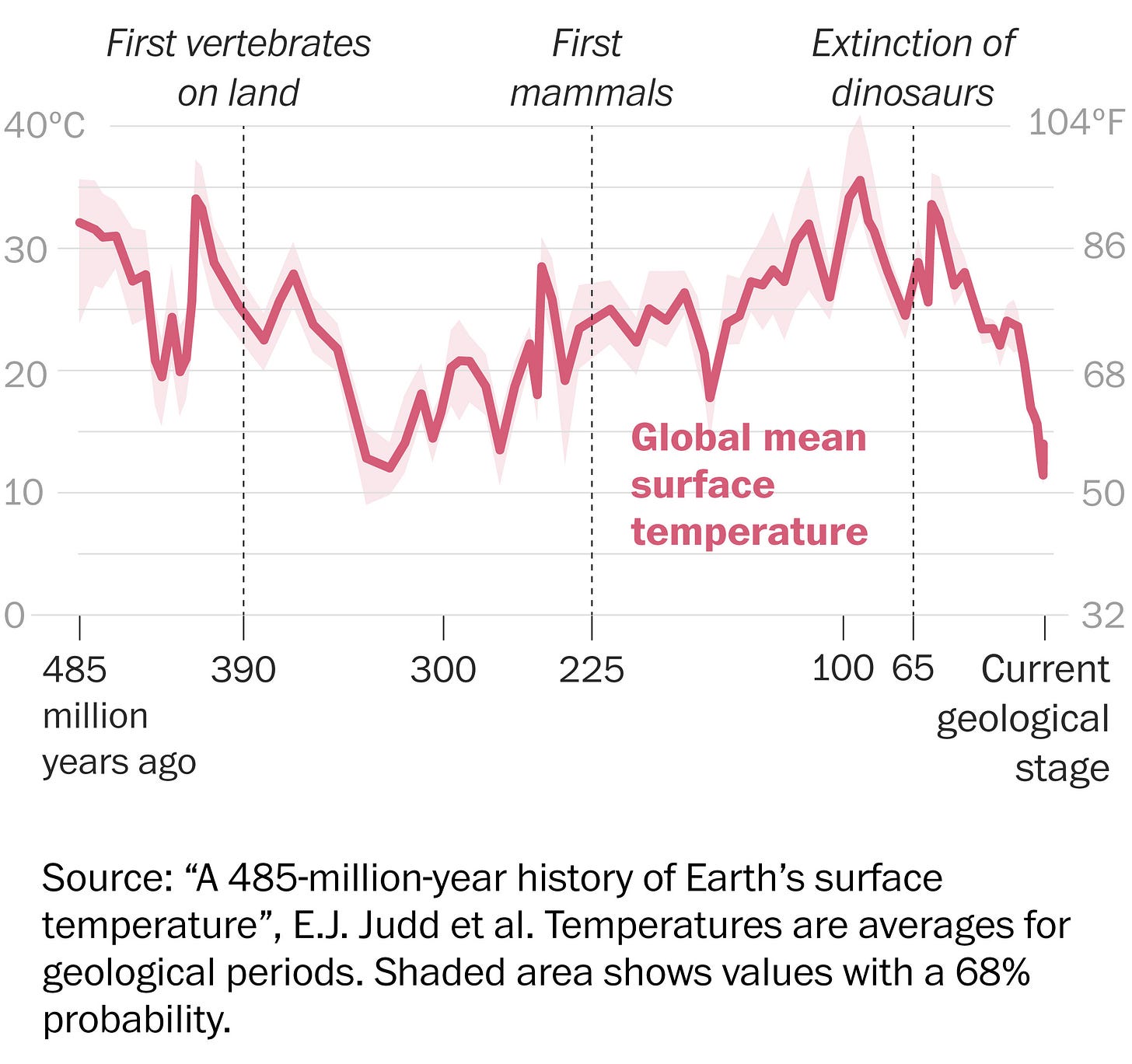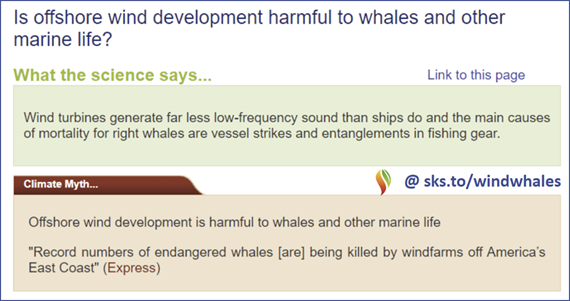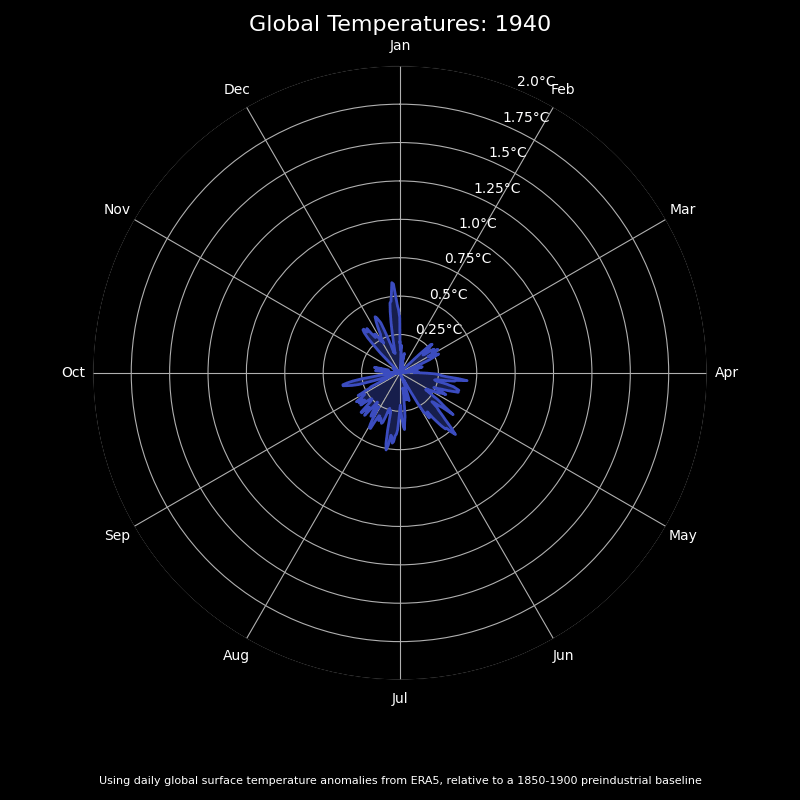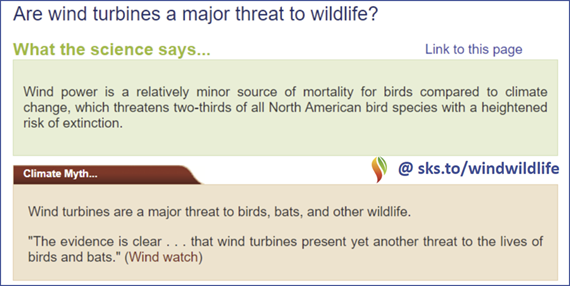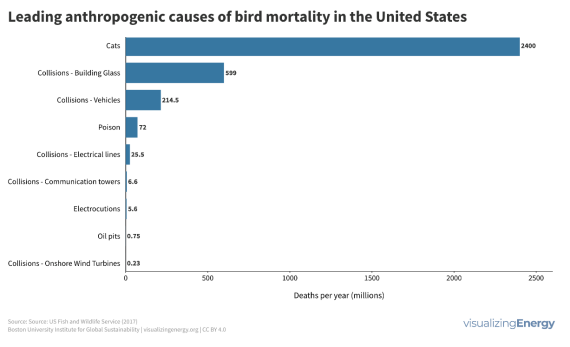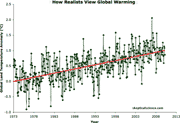Explaining climate change science & rebutting global warming misinformation
Global warming is real and human-caused. It is leading to large-scale climate change. Under the guise of climate "skepticism", the public is bombarded with misinformation that casts doubt on the reality of human-caused global warming. This website gets skeptical about global warming "skepticism".
Our mission is simple: debunk climate misinformation by presenting peer-reviewed science and explaining the techniques of science denial, discourses of climate delay, and climate solutions denial.



Posted on 3 April 2025 by Doug Bostrom, Marc Kodack
Open access notables
A pronounced decline in northern vegetation resistance to flash droughts from 2001 to 2022, Zhang et al., Nature Communications:
Here we show that vegetation resistance to flash droughts declines by up to 27% (±5%) over the Northern Hemisphere hotspots during 2001-2022, including eastern Asia, western North America, and northern Europe. The notable decline in vegetation resistance is mainly attributed to increased vapour pressure deficit and temperature, and enhanced vegetation structural sensitivity to water availability. Flash droughts pose higher ecological risks than slowly-developing droughts during the growing seasons, where ecosystem productivity experiences faster decline rates with a shorter response time. Our results underscore the limited ecosystem capacity to resist flash droughts under climate change.
Climate denial and the classroom: a review, Kutney, Geoscience Communication:
Climate change awareness is floundering across the globe despite climate change education being embedded in international treaties to address the climate crisis – the United Nations Framework Convention on Climate Change (the UNFCCC) and the subsequent Paris Agreement. The Intergovernmental Panel on Climate Change (IPCC) acknowledges forces hostile to climate awareness and education – namely, climate denial sponsored by the energy-industrial complex. Climate change is studied by the physical sciences, but climate denial is the purview of the social sciences; the latter has revealed the why and how of climate denial. Climate-denial organizations (which directly deny aspects of the scientific consensus on climate change) and the related petro-pedagogy groups (which teach that oil is a benefactor to humanity, but say little about the connection of fossil fuels to the climate crisis) have arisen to attempt to interfere with the teaching of the science of climate change in school classrooms. These organizations were found in the United States, Canada, and some European nations (this review is mainly restricted to English-language sources). This review aims to (1) provide an overview of climate denial, promoted and funded by the energy-industrial complex; (2) identify and examine organizations involved in climate denial in schools; (3) summarize the strategies of climate-denial organizations in school classrooms; and (4) put forward recommendations for further research and action.
Most Christian American religious leaders silently believe in climate change, and informing their congregation can help open dialogue, Syropoulos & Sparkman, Proceedings of the National Academy of Sciences:
Nearly 90% of U.S. Christian religious leaders believe in anthropogenic climate change, with most believing human activity is a major contributor. Yet roughly half have never discussed it with their congregation, and only a quarter have mentioned it more than once or twice. U.S. Christians substantially underestimate the prevalence of their leaders who believe in climate change. Providing the actual consensus level of religious leaders’ belief in climate change reduces congregants’ misperception of religious leaders, increases their perception that other church members believe in and are open to discussing climate change, and leads Christians to believe that taking climate action is consistent with their church’s values while voting for politicians who will not take climate action is not.
Why do Australians prefer some climate migrants over others?, Martínez i Coma & Birch, Environmental Politics:
We investigate attitudes toward climate migration in Australia, exploring support for different climate migrants and the role of environmental attitudes in conditioning this support. After confirming the results of previous studies on other countries – climate migrants fall in the middle of the preference scale over migrant types – we offer novel evidence that individuals attaching greater salience to the environment are more likely to distinguish between different types of climate migrants. We attribute this result to the level of cognitive engagement with climate migration. We address these questions via a representative online survey which embeds a conjoint experiment, combined with 25 interviews with federal and state members of parliament. Overall, Australians, and especially those for whom the environment is salient, prefer migrants coming due to rising sea levels over those migrating due to drought. The analysis of the MP interviews suggests a logic to interpret these preferences.
Climate obstruction at work: Right-wing populism and the German heating law, Haas et al., Energy Research & Social Science:
The intense debates surrounding the so-called heating law (Gebäudeenergiegesetz, GEG) in Germany demonstrate that socio-technical transitions and policies aimed at achieving net zero should be conceptualized as socially contested processes to adequately reflect their societal and political character. We argue that more recent research on sustainable transitions that looks at the role of incumbent actors, and especially the concept of ‘climate obstruction’ is helpful for better understanding the delay of climate policies. Based on this assumption, we analyze the campaign against the law and identify five central discursive strands brought forward to dismantle the law: Expropriation (1), Disenfranchisement (2), Ideological Driven (3), Green Cronyism (4), and Demand to Take Everyone Along (5).
From this week's government/NGO section:
Consecutive extreme heat and flooding events in Argentina highlight the risk of managing increasingly frequent and intense hazards in a warming climate, Zachariah et al., World Weather Attribution
To assess to what extent human-induced climate change altered the likelihood and intensity of the heavy precipitation leading to the severe flooding in Argentina, as well as the extreme heat the authors undertook an attribution study for the extreme rainfall in the most affected region, that coincides with the area where flood warnings were in place. Climate models show that climate change is making such temperatures much more frequent and intense. However, the increase in the models is smaller than in reanalysis products and thus likely underestimating the effect of climate change. Nevertheless, looking at the future, models show a very strong trend that increases with future warming, rendering such an event a common occurrence in a 2.6°C warmer climate compared to pre-industrial. The influence of climate change on the rainfall event is much less clear. While all of the 35 available weather stations in the area show an increase in the intensity of heavy rainfall of between 7-30% associated with global warming of 1.3°C, this is not represented in any of the available gridded reanalysis products which show on average a decreasing trend.
State of the Climate in Latin America and the Caribbean 2024, Marengo et al., World Meteorological Organization
The authors provide the status of key climate indicators and information on climate-related impacts and risks. They address specific physical science, socio-economic, and policy-related aspects that are relevant to Latin America and the Caribbean and respond to Members needs in the fields of climate monitoring, climate change, and climate services. For example, the mean temperature in Latin America and the Caribbean in 2024 was +0.90 °C above the 1991–2020 average, making 2024 the warmest or second warmest year on record, depending on the dataset used.
118 articles in 55 journals by 809 contributing authors
Physical science of climate change, effects
The greater role of Southern Ocean warming compared to Arctic Ocean warming in shifting future tropical rainfall patterns, Park et al., Open Access pdf 10.21203/rs.3.rs-5139656/v1
Observations of climate change, effects
Abrupt sea level rise and Earth’s gradual pole shift reveal permanent hydrological regime changes in the 21st century, Seo et al., Science 10.1126/science.adq6529
Read more...
0 comments
Posted on 2 April 2025 by BaerbelW, John Cook
In February 2025, John Cook gave two webinars for republicEN explaining the scientific consensus on human-caused climate change.
20 February 2025: republicEN webinar part 1 - BUST or TRUST? The scientific consensus on climate change
In the first webinar, Cook explained the history of the 20-year scientific consensus on climate change. How do we know there’s a scientific consensus on climate change? How did we get there, and what exactly does it all mean?
The webinar "Bust or Trust? The scientific consensus on climate change," focused on establishing that there is a scientific consensus on climate change and how to communicate that effectively.
The existence of a scientific consensus is supported by multiple studies conducted over the past 15 years. These studies consistently show that over 90% of climate experts agree that humans are causing global warming, with many studies finding agreement around 97-98%. This consensus has been demonstrated through various research methods, including surveys of scientists and analyses of published climate papers.
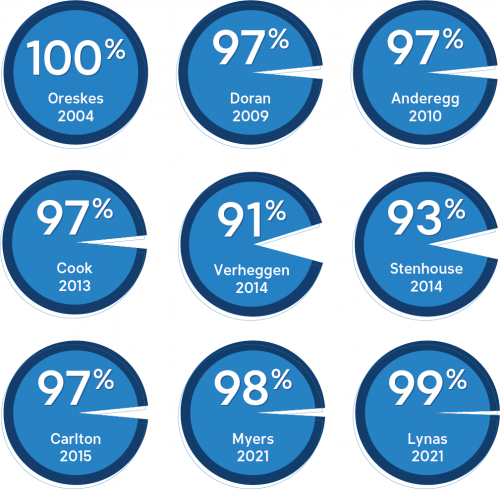
Despite this overwhelming scientific agreement, public perception of the consensus remains low. Only 30-50% of people believe that scientists agree on global warming. This gap between scientific consensus and public perception is due to several factors, including cultural and political biases, misinformation, and a lack of awareness. The webinar emphasized the importance of effectively communicating the scientific consensus to bridge this gap and promote informed action on climate change.
The first presentation can be downloaded as a PDF (5MB).
Read more...
0 comments
Posted on 1 April 2025 by Ken Rice
On November 1, 2024 we announced the publication of 33 rebuttals based on the report "Rebutting 33 False Claims About Solar, Wind, and Electric Vehicles" written by Matthew Eisenson, Jacob Elkin, Andy Fitch, Matthew Ard, Kaya Sittinger & Samuel Lavine and published by the Sabin Center for Climate Change Law at Columbia Law School in 2024. Below is the blog post version of rebuttal #22 based on Sabin's report.
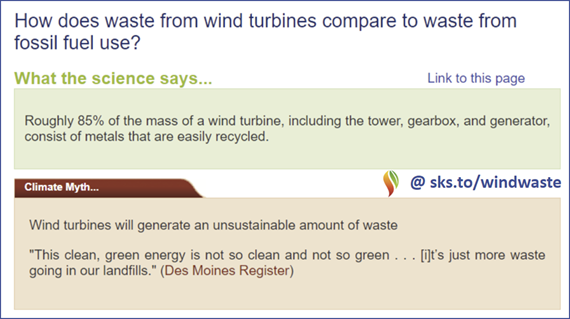
Roughly 85% of the mass of a wind turbine, including the tower, gearbox, and generator, consist of metals that are easily recycled1 (also Khalid et al. 2023). The remaining 15%, including the blades, consist of composite-based materials, such as fiberglass, that are more difficult to recycle (Khalid et al. 2023). However, new technologies are in development for recycling turbine blades, and turbine blades are in fact being recycled in some facilities2 (also Jensen & Skelton 2023). A recent breakthrough supported by the Department of Energy enabled all turbine components to be recycled3, and private companies in the United States have begun developing turbine blade recycling plants.4
One study from 2017 estimated that global annual waste of turbine blades will reach 2.9 million metric tons per year by 2050, with a total of 43 million metrics tons in cumulative waste generated between 2018 and 2050 (Liu & Barlow 2017). This is not insignificant. However, Nature Physics has projected that global cumulative waste from fossil fuel-based power generation between 2016 to 2050 is expected to produce roughly 45,550 million metric tons of coal ash alone, along with 249 million metric tons of oily sludge (Mirletz et al. 2023). In other words, the cumulative waste from coal ash is expected to be roughly 1,000 times greater than that of turbine blades, and the cumulative waste of oily sludge is expected to be about 5-6 times greater than that of turbine blades. Importantly, both coal ash and oily sludge are known to be toxic. For further context, in the United States alone, roughly 600 million short tons, or 544 million metric tons, of construction and demolition debris were generated across all sectors in 2018.5 In effect, the annual construction and demolition waste in the United States alone is roughly 187 times greater than the anticipated annual waste from wind turbine blades across the globe in 2050.
Read more...
0 comments
Posted on 31 March 2025 by Guest Author
This is a re-post from Yale Climate Connections by Karin Kirk
When former President Joe Biden left office, the Department of Energy was overseeing more than $300 billion in public and private investments in clean energy under the Inflation Reduction Act. Nearly three-quarters of these investments were slated to flow to states that voted for President Donald Trump in the 2024 election, a Yale Climate Connections analysis shows.
But on the first day of his second term, President Donald Trump signed an executive order attempting to halt some payments under that law, with the potential to hurt his own voters the most.
A landmark climate law
The Inflation Reduction Act, or IRA, passed by Democrats in 2022, made ambitious commitments to modernize the nation’s energy sources, boost competitiveness in new energy technology, grow American manufacturing jobs, and reduce climate-warming pollution. It committed at least $369 billion to energy and climate programs, to be distributed through multiple programs and agencies over 10 years.
The Trump administration has attempted to pause further payments from the IRA, including those that had been already approved. For example, the administration froze funding for the Environmental Protection Agency’s Solar for All program, which had already begun giving out $7 billion in grants to help purchase and install solar panels for lower-income households. Weeks later, the funding for that program was restored, and it remains unclear if courts will allow the Trump administration to freeze IRA funding that had already been appropriated.
The uncertainty around many IRA programs seems likely to disrupt planning for new projects and investments. This is especially true for projects with a multiyear planning process, such as battery factories, electrical grid upgrades, and electric vehicle plants. The situation is ever-evolving, and you can track recent changes with the Inflation Reduction Act Tracker.
How the Inflation Reduction Act works
- The IRA aims to reduce climate-warming pollution across many facets of society and is funded through multiple government agencies.
- For example, the EPA offers rebates for clean heavy-duty vehicles, the USDA is funding efforts to improve soil carbon uptake on farmlands, and the Department of Energy is using tax credits to incentivize the construction of new clean energy projects. The Inflation Reduction Act Database lists the programs at each agency.
- The federal government provides direct funding to projects in some cases.
- In other cases, the government offers a tax credit as an incentive for a private company to build a new project. For clean energy projects, these private investments are greater than the government funding. For example, spending $740 billion in tax credits from the IRA was expected to generate $2 trillion in private investments.
- Funding for energy and climate programs under the IRA was originally expected to cost $391 billion. Since then, many of the tax credits have proved to be more popular than originally anticipated. As more companies and individuals claim tax credits, this raises the price tag of the IRA, but it expands the benefits, too.

































 Arguments
Arguments




























